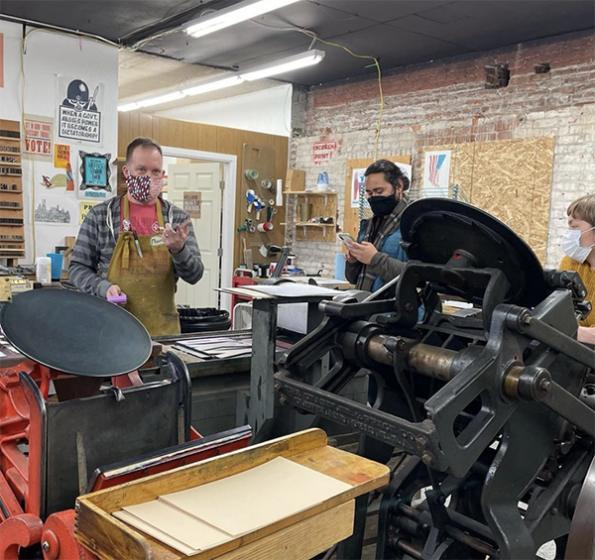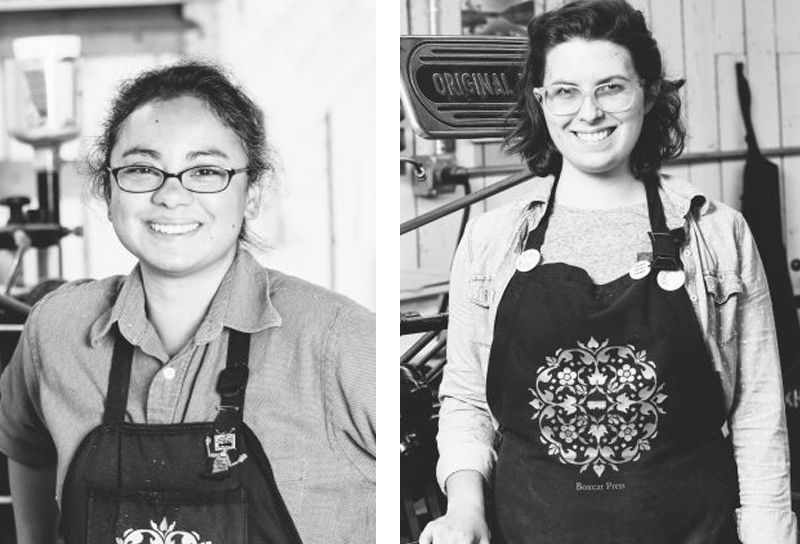Printing on press is as much a personal creative time as it is an experience you just can’t wait to share with others. This is an observation from Thom Caraway of the Spokane Print & Publishing Center. The full-time teacher and Center organizer has enjoyed creating a space where all interested in the craft could roll-up their sleeves and get inky. We spent time with Thom to talk shop, and to see how the printing world in Spokane is being discovered by others at their printing paradise.

GEARING UP FOR PRINTING ADVENTURES I’m a university English professor in Spokane, Washington via Whitworth University. I write poetry and teach classes in editing, book design, and print culture.
In 2015, I inherited a C&P from a printmaking professor who didn’t want it in the school art studio anymore. I was excited about it but had no idea what to do with it (or even how it worked). Shortly after, I met Bethany Taylor, who was getting her shop off the ground, and we decided to make a place where neophytes could come learn. She’d been to the Independent Publishers Resource Center (IPRC) in Portland, and we modeled ourselves off of their space and got going.

PRINTING CENTER COMMUNITY We closed Iteration one in 2018 when our lease ran out, and moved into the new space as Spokane Print & Publishing Center in 2019. With the bigger space, we were able to add more presses and expand from letterpress and screenprint into relief and etching as well. Later, we added book arts and digital design and printing. My favorite thing is when there are members spread out across the shop all working on different awesome things, especially if several presses are going at once.
ALL IN THE NEIGHBORHOOD We’re a 5-minute drive from the Kendall Yards neighborhood and the Spokane River. Downtown is just across the river, so we are close to food and shopping.

PRINTING MENTORS Letterpress Instagram kind of kept me sane during lockdowns, and with no formal art or print shop training, I’m a big fan of the School of Bad Printing. Amos Kennedy, Mizdruk, Fresh Lemon Press, Bright Press, Marcos Mello. Also Rick Griffith, Amy Redmond, Ben Blount, Chris Fritton, Base Press, Stephanie Carpenter…so many great printers out there!
PART-TIME PRINTER, FULL-TIME FUN This is a side hustle from my day job teaching. I would love to get to a point where I could print full time though.

THE CREATIVE PROCESS I’m becoming more of a planner, but mostly I’m a seat-of-my-pants designer. I like seeing what happens with different applications of color, and big messy press beds full of wood type. From there, I might layer in a quote or phrase, or play around with the letterforms of larger wood type to see what happens.

PRINTING FEATS Making a more formal turn from writing to printing in the last four years has been a lot of fun, if a little nerve-wracking at times. But mostly I’m proud of our little shop. We’ve weathered COVID well, and offer classes pretty much every week now. I feel like we’re really developing Spokane’s appetite for the print and book arts, and training up a bunch of new printers!
PRESS HISTORY I have that first press – a C&P Old Style with a broken flywheel axle. Have still never gotten that thing fully functional.

BOXCAR’S ROLE We’ve gotten a bunch of ink from Boxcar, and had some plates made. And we’ve been meaning to order some logo plates, too!
PRINTING TIPS & TECHNIQUES I print mostly now on a Vandercook 14, which is really basic, so no ink rollers. Everything is applied by hand. My advice for letterpress printers is don’t be afraid to mess it up a bit. I love a nice clean print as much as anyone, but I’m also really interested in the accidents and goofs. Those are usually my favorites.

WHAT’S COMING NEXT I’ve got a full slate of letterpress classes spread through the year. I am hoping to grow our membership base once things open back up, and continue developing our Print Town USA events, which get the public into the shop for sales and demos, and are just a lot of (socially-distanced) fun.
A double round of applause & thanks out to Thom of Spokane Print & Publishing Center for letting us take a sneak peak at the wonderful community-driven printing center!















 (photography courtesy of TOGETHER/Pahzit Cahlon)
(photography courtesy of TOGETHER/Pahzit Cahlon) (photography credit: NASA/JPL-Caltech)
(photography credit: NASA/JPL-Caltech)


